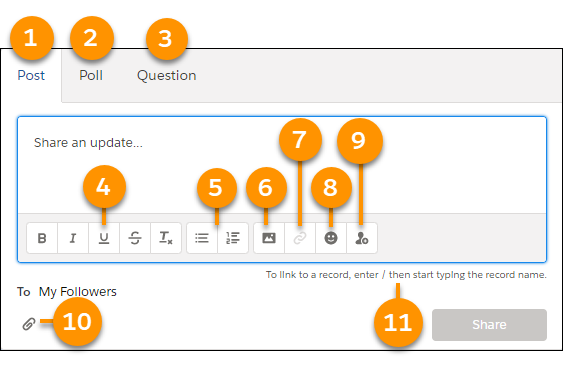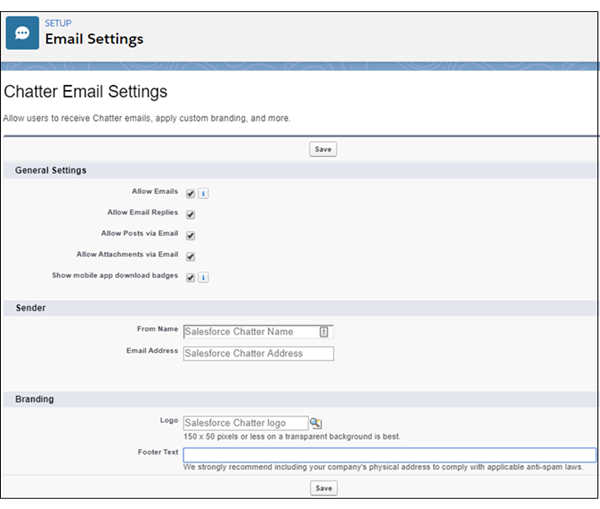Get Started with Chatter
Learning Objectives
After completing this unit, you’ll be able to:
- Identify Chatter publisher features.
- Enable Chatter email notifications.
- Locate and describe org settings for Chatter.
A Light Review of Chatter
As a Chatter admin, you’re likely familiar with what Chatter is and what you can do with it. This section includes a few highlights to refresh your Chatter knowledge.
To get a full understanding of Chatter in Lightning Experience, start with the module Chatter for Lightning Experience.
Navigate to Chatter
It’s easy to get to Chatter features directly from the Chatter page. Click the Chatter tab (or the Chatter option on the overflow menu). If you don’t see the tab or the option, click the App Launcher, search for Salesforce Chatter, and click it.
Chatter Feeds
A Chatter feed combines the Chatter publisher and the posts, polls, questions, comments, and other objects added through the publisher. Use the publisher to write a post, ask a question, and create a poll. You can also make other actions available to your users through Setup.

Here are the typical elements of a Chatter publisher:
- Post tab
- Poll tab
- Question tab
- Font styles, including remove styles action
- List styles
- Inline image (copying inline images from external sources and pasting them into the editor isn’t supported)
- Inline Hyperlink (hyperlinking inline images isn’t supported) Note: Highlight link text before you click the hyperlink icon. If your hyperlink URL gets an error, check its syntax to ensure that:
- The URL starts with http:// or https://.
- The hostname and file name are correct.
- The URL doesn’t point to a localhost domain.
- Emoji selector
- @Mention action
- Add file action
- Link-to-record prompt
Depending on how you set up Chatter for your org, everyone with access to a post can comment on it, like it, and share it. They can also bookmark or mute it. The author and some permitted users can edit and delete the post. People can delete their own posts, but under most circumstances, they can’t delete other people’s posts or generated posts. For example, they can’t delete record updates, such as a post about a changed field on an account.
Enable Chatter Email Notifications
When you enable email notifications for Chatter, your users start receiving email notifications about new posts, comments, and other changes.
Your users can keep the default notifications that you set up, or they can override your settings with their own. Users can control whether they receive emails, the changes that trigger emails, and the frequency of delivery. It’s important to let your users know how they can control the amount of email they receive. Some Chatter users experience too many email notifications, and it can be a barrier to adoption.
Enable email notifications for all users in Setup, on the Chatter Email Settings page. Set up the types of email allowed, your org’s Chatter email address, and the footer information to include in every email. Use the footer to add your org branding, like your logo and company address.
- In the Setup Quick Find box, enter
Email Settings, and click Email Settings.
- Select
-
Allow Emails to turn on Chatter email notifications for all your users.
-
Allow Email Replies to allow users to post their replies to email notifications in Chatter.
-
Allow Posts via Email to allow users to post to groups through email.
-
Allow Attachments via Email to allow users to include attachments when they use email to post to a group.
-
Show mobile app download badges to add App Store and Google Play badges for the Salesforce app to all Chatter email notifications from your internal org. The download badges help increase user adoption of the Salesforce app.
- Under Sender, enter the name and email address for your org’s Chatter email account.
- Under Branding, provide an image, like your company logo, sized for email, and a footer that contains your company address.
- Click Save.
Don’t let your users get overwhelmed by Chatter email notifications. Recommend that they choose to be notified only when they’re @mentioned in a post or comment.
Review Your Chatter Settings
Let’s review Chatter Settings so you know where they are and what’s available to you.
To get to Chatter Settings, from Setup enter Chatter in the Quick Find box, and click Chatter Settings.
This table describes these settings and discusses what happens when you enable or disable them.
Section |
Description |
Enable to … |
Disable to … |
|---|---|---|---|
Chatter Settings |
Turns Chatter on or off for your org. |
Make Chatter available in your org. |
Remove Chatter from your org. If you remove Chatter in Salesforce Classic, global search is also removed. If you remove Chatter in Lightning Experience, global search remains available. |
Groups |
Provides options for your Chatter groups. Controls whether archiving is enabled, whether you can associate records with groups, and whether unlisted groups are allowed in your org. |
Allow Group Archiving: Provide the option of archiving a Chatter group. Allow Records in Groups: Include add-record actions in groups, and show records related to the group in a group’s detail view. Enable Unlisted Groups: Allow the creation of private groups that aren’t included on the group list page. Membership in unlisted groups is by invitation only. |
Allow Group Archiving: Disable group archiving, and remove the Disable automatic archiving setting from the New Group dialog. Allow Records in Groups: Prevent the creation of records, and remove the Records section from a group detail page. Enable Unlisted Groups: Prevent the creation of unlisted groups in your org. |
Draft Posts |
Adds the My Drafts feed to the Chatter page. Every seven seconds, saves posts that users are drafting and make them available in the My Drafts feed. When the user posts the entry, the draft is automatically removed from the My Drafts feed. |
Automatically save users’ draft posts every seven seconds. Posts are saved as drafts. Questions and polls are not saved as drafts. |
Prevent the appearance of the My Drafts feed on the Chatter page, and suppress the saving of draft posts. |
Rich Link Previews in Feed |
Converts links in posts into embedded videos, images, and article previews. Larger images are truncated with a More link that lets your users see the full preview. |
Show links as previews to give users a visual reference to the link’s target and the ability to play videos in place. |
Show links as links, and require that users navigate to the link target to see what it’s about. |
Emoji in Feed |
Converts keyboard characters into emoji so these keyboard characters :) become this emoji |
Allow the conversion of keyboard characters into emoji. |
Prevent the conversion of keyboard characters into emoji. |
Out of Office |
Adds a control to user profile pages for setting a personal out-of-office message. |
Add the out-of-office setting to user profile pages. Out-of-office messages appear anywhere the user’s name appears in the org. |
Omit the out-of-office setting from user profile pages. |
Topics |
Allows guest users and authenticated external users to view topics in Salesforce Sites and portals. |
Let users inside and outside your org view topics in Salesforce Sites and Portals. This setting is for increased security of topic names in your org. Salesforce turned off topics for guest and authenticated external users in Salesforce Sites and in portals created before Summer ’13. If you want to enable topics for external users, go to Setup | Chatter Settings and select Allow topics in Salesforce Sites and Portals. |
Prevent guest users and authenticated external users from viewing topics in Salesforce Sites and portals. |
Approval Posts |
Allows requests for approval to appear in a user’s feed. |
Post approval requests in a user’s feed. |
Prevent approval requests from appearing in a user’s feed. |
Coworker Invitations |
Allows licensed Salesforce users to invite unlicensed coworkers to Chatter. Users who accept invitations see only profiles, files, and groups. They can't see any object details unless you grant them a full Salesforce license. |
Let licensed users invite unlicensed coworkers to Chatter. |
Prevent licensed users from inviting unlicensed coworkers to Chatter. |
Customer Invitations |
Allows licensed users to invite customers to private groups that the licensed user owns or manages. Licensed users can invite customers who are from outside your email domains. Invited customers can see information only in the groups that they're invited to. They can interact only with members of those groups. |
Let a licensed user invite customers to a private group that the licensed user owns or manages. |
Prevent licensed users from inviting customers to the private groups that the licensed user owns or manages. |
Actions in the Publisher |
Actions in the Publisher is a legacy setting that has no application in Lightning Experience. |
Doesn’t apply. |
Doesn’t apply. |
Recommendations in the Feed |
Allows the posting of recommendations for using the Salesforce Today app in your users’ feeds. |
Automatically post recommendations for using the Salesforce Today app in your users’ feeds. |
Prevent automatic posting of recommendations for using the Salesforce Today app in your users’ feeds. |
Post and Comment Modification |
Lets certain users edit feed posts and comments. Affected users include the author, the person who owns the record that was posted or commented on, and the Chatter or community moderator. |
Allow certain users to edit posts and comments. |
Prevent everyone from editing posts and comments. |
Rich Text Posts |
Makes the editor in the Chatter publisher a rich text editor. The rich text editor supports text formats, inline images, hyperlinks, and, when enabled for the org, code snippets. |
Use the rich text editor in lieu of a plain text editor in the Chatter publisher. |
Use a plain text editor in the Chatter publisher. |
Pin Posts in Feeds |
Make post pinning available to your communities and your internal org. First make the feature available through this setting, then assign permission to pin through profiles or permission sets. When the permission is assigned, users can pin up to three posts to the top of the Topics and group feeds that they can access. |
Make a post pinning permission available for assignment through a profile or permission set. |
Prevent people from pinning posts in Topics and group feeds. |
Case Feed Timestamps |
Choose between absolute and relative date and time stamp formats on posts and comments in Case feeds. If you navigate to a feed item’s detail view, the time stamp is always relative. When relative time is in effect, users can see the absolute date and time stamp by hovering over the stamp. |
Show relative date and time stamps on posts and comments in Case feeds. 10 minutes ago Just now 2 hours ago |
Show absolute date and time stamps on posts and comments in Case feeds. Feb 18, 2020, 2:29 PM |
Now that you know more about Chatter, let’s move to the next unit to take a closer look at Chatter’s main collaboration space: groups. But first, let’s test your knowledge!
Resources

 .
.